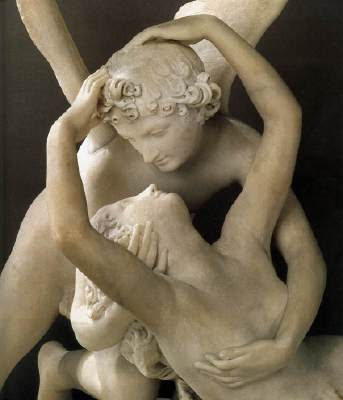Neoclassical goddesses and Romantic Heroines:
Part One
LOUISE OF PRUSSIA by Tischbein
 |
| Louise of Prussia, when Crown Princess, 1796, by Tischbein. Image source: damals.de |
Louise, queen of Prussia (1776 - 1810), was one of the last and most accomplished of the
Enlightenment's children among the European ruling class, educated
under the principles of Rousseau, her imagination and taste fed on
Schiller, Goethe and Shakespeare, a princess who could say after
climbing the Schneekoppe mountain that she felt nearer to her god, and mean it.
During
the Napoleonic Wars, in which Prussia, that had seemed invincible a
generation earlier under Frederick the Great, was conquered by the
French,
Louise provided inspiration to the nation and to
her husband, who relied upon her resolution
and courage to the extent that Napoleon mockingly called her "the only
real man in Prussia".
During her lifetime she was given more adulation than any other
German queen consort; when she died aged thirty-four in 1810, frozen in
time as a young mother, she was instantly mythologized, and became a
symbol of German national unity and
womanhood over a century before those ideals were perverted by the
Nazis.
She was born on 10 March, 1776, into the minor ducal family of
Mecklenburg-Strelitz in Northern Germany that was related to the
Hanoverians by the marriage of her
aunt Charlotte to King George III. The family's prestige continued to be
raised by the next female generation on the marriage market.
The
youthful beauty of Louise and her three sisters excited Romantic
intellectuals like Goethe, who optimistically welcomed their appearance
as a "heavenly vision" of aesthetic ideals, as much as prosaic German
princes on the look-out for dynastic breeding mares.
The eldest sister, another Charlotte, later admired for her singing
voice and literary patronage, was married off aged sixteen to the
boorish Duke of Saxe-Hildburghausen, and it was her younger sisters,
Louise and Friederike, who were snatched up later for the greater
marital prizes, both eventually becoming queen consorts. The unamiable
characters of all their husbands amid the upheavals of European war
pre-empted fairy-tale endings for any of the sisters.
Only Louise, who
became a mother of ten, was to achieve domestic happiness, with the
determination of a mission. She was pregnant for most of her
seventeen-year marriage to Frederick William III of Prussia, and still
found time to promote government reform, defy Napoleon and rally the
nation during wartime defeat.
 |
| One of the most famous images of feminine beauty in German neoclassicism, JG Schadow's Prinzessinnengruppe
of the sisters Louise and Friederika of Mecklenburg-Strelitz.
Sculpture, 1795, collection of the Nationalgalerie, Berlin. At the time,
both sisters were married to princes of Prussia. Louise's husband
succeeded as king in 1796. The casual intimacy of the pose and the
fashionably clinging dresses of real-life princesses shocked some
contemporaries, used to more pompous formal presentations of royalty. |
Early lessons in a cycle of matriarchal loss and replacement informed
Louise's personal quest for emotional stability and her adult sense of
maternal and social responsibility. Her mother died when she was six;
after two years, her mother's younger sister stepped into the gap as
step-mother to the young family, but she died in childbirth only a year
later.
Her grandmother, Marie Luise Albertine of Darmstadt, took over
the care and education of the children of both the daughters who had
predeceased her, bringing them up in a more affectionate and relaxed
environment than was usual in contemporary aristocratic families.
Intelligent, strong-willed and energetic, sustained by moral purpose and
a belief in her historical destiny, Louise welcomed the power her royal
status gave her to perform charitable works and practise the liberal ideas of the 18th century
philosophers and support military and social reformers within the absolutist Prussian government.
She
was both typical of her time and ahead of it, a once and future
heroine, whose natural warmth and spontaneity escaped caste boundaries,
even at the repressive Berlin court. Instinctively pleasure-loving and
light-hearted, she proved her fortitude and capacity for self-denial in
exile for three years in
Koenigsberg, in the far eastern reaches of Prussian territory, near the
Russian border.
During the French occupation, Louise expressed
solidarity with the Prussian people through the simplicity of her dress
and life-style, though she still tried to keep up with French fashions.
She loved clothes extravagantly for their own sake, and also for their
iconic value to her official position as queen and leader of
neoclassical fashion in Germany.
Louise performed a balancing act as wife, mother and leader,
scrupulously combining her career as chief political adviser to her
husband with being his outwardly obedient consort, reining in reforms
that she knew would exceed his tolerance, and matching her gentleness as
a mother with the fierce resolve of a war leader.
With foresight, she
fought for the country's
independence from the opposing threats of imperial French and Russian
power, and died when the cause still looked hopeless, before the Allied
victories of 1812 to1815. Her husband and the nation sanctified her as
a Prussian sacrifice to
the Corsican Monster.
From then on, her personality was distorted by popular culture and
nationalist politics. Recently, historians, novelists and bloggers have
attempted to disentangle the real Louise from all her various
incarnations, domestic goddess, warrior queen and benevolent saint. who
remains one of those historical figures on whom we continue to project
our own
aspirations and prejudices, shifting the focus as it suits us.
LOUISE OF PRUSSIA





























